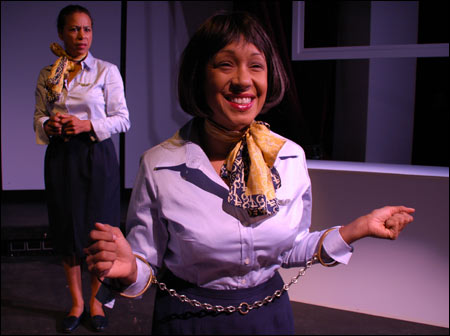Mileage may vary, but by and large we'll get farther laughing instead of crying. At least that was the observation of George C. Wolfe in The Colored Museum, also a conclusion of African-Americans historically. The jam-packed play is getting a rip-roaring rendition at the Providence Black Repertory Company (through November 19).

SATIRE WITH A SMILE: Lambert as a shackled stewardess.
|
The 11 sketches on display all have the frolicking loopiness of skits on a black Saturday Night Live, but most also have an underlying serious intensity that make them ready for theatrical prime time.
Although the comedy is broad and vaudevillian, the five actors, skillfully directed by Don Mays, each let us glimpse that they're capable of more. The sketches are double-layered too, as you'd expect from settings that run from a slave ship and a Vietnam War battlefield to a nightclub and a cooking show.
The opening bit, surreal and sardonic, sets just the right tone for what's to follow. We have taken our seats on Celebrity Slave Ships, and a perky stewardess (Pamela Lambert) tells us how she wants to make our Middle Passage a pleasant experience. She cheerfully instructs us to wear our shackles at all times, unless we want to stretch or dance in the aisles. But drumming is, of course, prohibited. When the inevitable drumbeat begins in the background, the second stewardess (Cilla Julia Bento) increasingly gets into tribal dancing when the first isn't looking.
ADVERTISEMENT
 |
The weaker sketches tend to make their points immediately and then merely draw them out. Lambert is an American expatriate chanteuse, freshly returned from Paris in the Josephine Baker mode, a southern drawl eventually, predictably, peeking out of her thick French accent. In a photo shoot for Ebony magazine ads, Bento and Keith Mascoll vamp and vogue as models “inside a world where everything is beautiful.” Dressed like Aunt Jemima, Marsha Z. West adds a little of this and a lot of that, from jazz to brash attitude, to cook up “a batch of Negroes” with just the right flavor.
The matter of attitude comes up a lot, as a crucial survival mechanism. That's most explicit, and most effective, in a piece titled “The Gospel According to Miss Roj,” where Mascoll plays a transvestite snap queen who banishes all hurtful encounters with assertive, in-their-face applications of the dismissive gesture. This is an easy candidate for the most effective insight in the play.
If playwrights had permission to be blunt about human suffering, they might be tempted to simply have actors howl for 90 minutes. But leaving out the artfulness would put artists out of work, so Wolfe gets sneaky. He ends the Ebony models scene with the words “no pain” as a segue to a soldier in Vietnam who, addressing other black men in his squad, says he knows the secret of their pain. Stepping out of an explosion dead but aware, the ghost foresees grim postwar fates for his friends. The step he takes to forestall those dark futures is extreme but plausible.
But funny, outlandishly funny, is the dominant mood here, although always against unhappy backgrounds. Two hairpieces (on the disembodied heads of Lambert and West) get a hallucinating Bento hysterical as they argue about whether straight hair or an Afro will create the best personality to hold up to her domineering boyfriend.
Likewise, in “The Last Mama-on-the-Couch Play,” the ensemble pulls out all the stops, chews up all the scenery in sight, and shows that there is no top too high to go over in a woe-is-us black melodrama. Poor Lorraine Hansberry and the anguished kitchen discussions of A Raisin In the Sun. Never again will a black playwright be able to up the villainy ante by having a crackhead drop a baby out of a window. Wolfe packs a lot in here, from chastising playwrights who use lofty diction to universalize the black experience, to having the archetypal Mama lament: “If only he had been born into an all-black musical, where nobody dies.”
The Colored Museum was written in 1986. Wolfe’s first big writing and directing hit was the 1991 Jelly's Last Jam, which convinced New York theatergoers that he can party. Two years later, his reputation was secured when Tony Kushner chose him to direct Angels in America on Broadway. Costumes by Ka Yan Kan are all on the money, as is the music by Kysia Bostick and musical direction by Clarice Laverne Thompson. A documentary montage by Julia Liu brackets the play, and digital images by Giti Shoresh provide scene transitions.